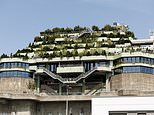
The skyline of Hamburg, an industrial German city, bears the scars of World War II.
During a sustained campaign of strategic bombing in 1943, a significant portion of the city was turned to rubble and tens of thousands of people were killed.
In the decades that followed the war, much of the city was rebuilt. The buildings that survived bore the markers of a painful chapter in Germany’s history.
One of the buildings which survived the bombings was the St. Pauli Bunker, which has stood for eight decades and is now a protected monument.
One of the two ‘flak towers’ in Hamburg, the St. Pauli Bunker was built in 1942 in just 300 days by prisoners of war and protected citizens from airstrikes.
The bunker, which was also known as Flakturm IV Hochbunker (literally ‘high bunker’), was one of the largest to be built in Hamburg.
The building was designed to hold 18,000 people, but during air raids in the summer of 1943 it is believed that up to 25,000 sought refuge there.
At the end of the Second World War, Hamburg had 1,051 bunkers – more than any other German city. Today, there are still around 650 bunkers left, with most of them underground or hidden behind residential buildings.
One of the two ‘flak towers’ in Hamburg, the St. Pauli Bunker was built in 1942 in just 300 days by prisoners of war and protected citizens from airstrikes
A pyramid-like shape was added to the existing high-rise bunker, creating a new ‘mountain path’ and rooftop garden with views of Hamburg
A four-star hotel, Reverb by Hard Rock, opened in July 2024 and is spread across five new floors
After the war, there were plans to demolish the building, but these were scrapped, and it has remained a city landmark ever since.
The St. Pauli Bunker served various civil purposes, including hosting Germany’s first television broadcast in 1950 and later becoming a venue for music and nightlife.
In 1946, in answer to post-war housing problems, windows were installed and a number of two-bedroom apartments were created, which were lived in until the 1970s.
The structure has been significantly expanded in a multi-million euro project. Starting in 2019, the structure was expanded with five new floors and converted into a contemporary cultural and leisure complex.
A pyramid-like shape was added to the existing high-rise bunker, creating a new ‘mountain path’ and rooftop garden with views of Hamburg.
A four-star hotel, Reverb by Hard Rock, opened in July 2024 and is spread across five new floors.
The project aims to repurpose the WWII bunker into a sustainable and green landmark.
A memorial to the victims of the Nazi regime and the Second World War is part of its new design, ensuring the past is not forgotten while the building is reborn with a new purpose.
NH Hotel Group laid out plans for a luxury hotel in 2019, with it initially supposed to open in 2022. Despite things slipping behind schedule, Hard Rock Hotels’ Reverb finally opened its doors in July 2024.
Pictured: The view through a window in the bunker building transformed into a park and leisure complex
Rooms at Hamburg’s Reverb start at £98.22 a night for a classic room, climbing to £179.20 for a king room
The St. Pauli Bunker (pictured) has stood for eight decades and is now a protected monument. Slide to see before and after the building’s renovation
Rooms at Hamburg’s Reverb start at £98.22 a night for a classic room, climbing to £179.20 for a king room.
Built during the darkest chapter in Germany’s history, St Pauli Bunker has now been given a new lease of life.
The bunker forms an important part of Hamburg’s history, and its heavy concrete walls and maze-like corridors serve as a reminder of the building’s past.
The building’s multi-purpose space encourages visitors to engage with its history, acting as a memorial and a symbol of resilience and renewal.
Source link
CHECK OUT: Top Travel Destinations
READ MORE: Travel News



